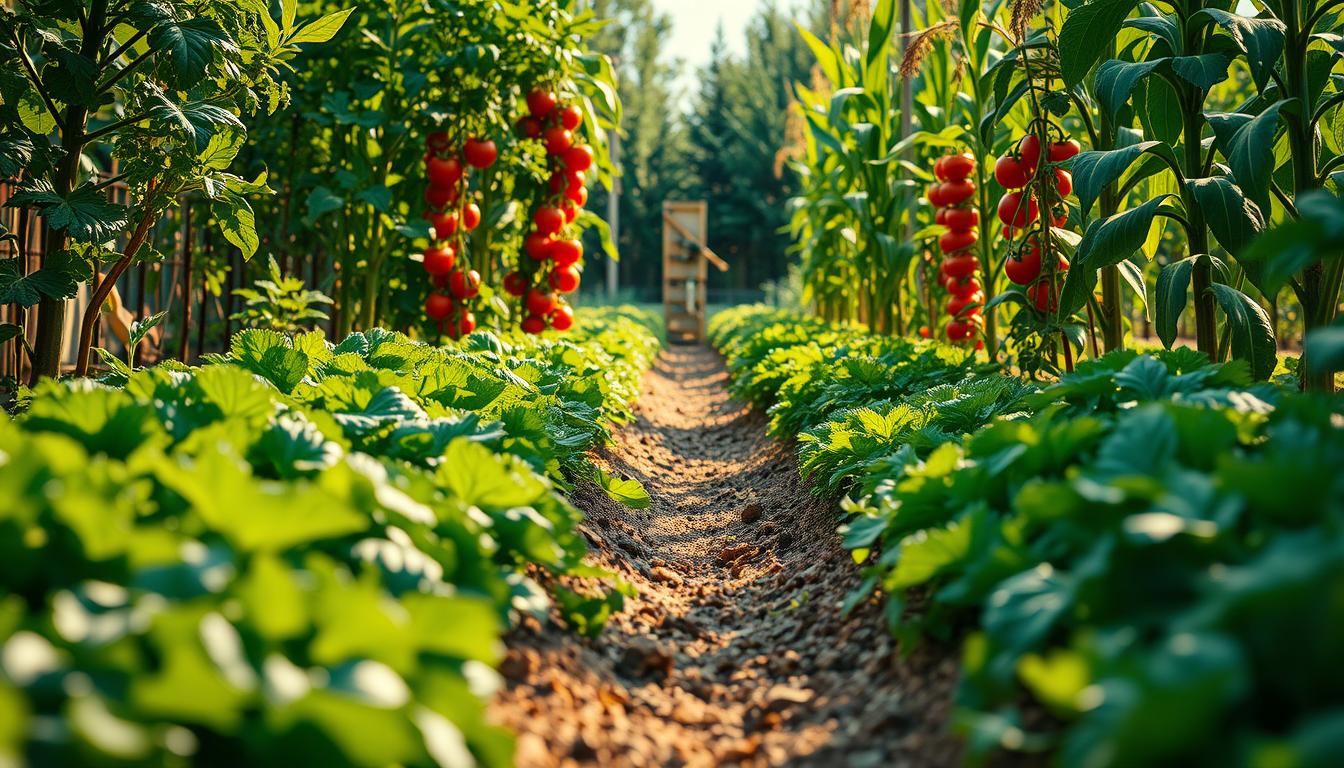Growing your own food is rewarding, but space can be a challenge. The good news? You don’t need acres to get a lot of produce. By picking the right varieties, even small gardens can be very productive.
Many gardeners face disappointing harvests, even when they try their best. The key often lies in the type of plants you choose. Modern breeding has made amazing vegetables that grow more in less space.
Whether you have a few containers on a balcony or raised beds in your yard, the right crops can change your gardening. These special varieties don’t just grow more. They also last longer, resist diseases better, and taste better.
This guide will show you the best vegetables for your garden and how to make the most of it. Get ready to enjoy a bigger harvest without needing more space!
Why Focus on High-yield Vegetable Varieties
In today’s world, food costs are rising, and garden spaces are limited. Focusing on high-yield vegetable varieties is a smart choice. Whether you garden in a small urban balcony or a dedicated backyard, the right varieties can boost your garden’s productivity. These varieties let you grow more food in less space, making gardening more rewarding and practical.
Modern plant breeding has led to vegetables that grow abundantly in various conditions. By choosing these productive varieties, home gardeners can turn small spaces into impressive food systems. This provides fresh produce all season long.
Space Efficiency in Home Gardens
High-yield vegetable varieties are great for saving space. They’re perfect for urban gardens, raised beds, and containers. These varieties are designed to produce more in less space.
Many of these varieties grow compactly but still produce a lot. For example, bush-type vegetables can yield as much as vining types but use less space. Vertical growing options like trellised cucumbers and pole beans also make the most of your garden’s height.
These space-saving varieties are perfect for gardeners with limited space. Even those with a small balcony can grow enough vegetables to make a big difference in their kitchen. Choosing the right high-yielding varieties is key.
Economic Benefits of Growing High-yielding Crops
Growing high-yield vegetables can save you a lot of money. A well-planned garden with these varieties can cut your grocery bills by hundreds of dollars a year. For example, a $3 packet of tomato seeds can yield dozens of pounds of tomatoes worth $50-100 at the store.
High-yielding varieties make these savings even bigger by producing more food per plant. You can also preserve your harvest through freezing, canning, or dehydrating. This way, you can enjoy your garden’s bounty all year, stretching your food budget further.
Plus, growing your own high-yield vegetables means you get fresh, nutritious produce at a lower cost. This is even more important during times of inflation or when grocery store prices and availability are affected.
Understanding Yield Potential in Vegetables
Before you start your garden, knowing what affects vegetable yield is key. Many gardeners pick varieties based on taste or looks, missing the yield factor. High-yield veggies can give you more food from the same space, but you need to look beyond the marketing.
Yield potential is the most a veggie can produce under perfect conditions. Different varieties can have huge yield gaps, with new ones often outdoing older ones. For those with small gardens, choosing high-yield varieties is a smart move.
The difference in harvests often comes from the right variety and growing methods. Let’s dive into what affects veggie yields and how to spot good claims when buying seeds.
Factors That Influence Vegetable Productivity
Several elements decide if a veggie variety will hit its yield potential in your garden. Knowing these helps you pick the best varieties.
- Genetic potential – Modern breeding has made varieties for higher yields, with better fruit set and disease resistance.
- Growing conditions – Your garden’s soil, sunlight, and water must match the variety’s needs for the best yield.
- Climate adaptation – Varieties made for your climate usually do better than those for other areas.
- Disease and pest resistance – Plants that fight off common pests stay healthier and produce more.
- Growing season length – Early varieties might not yield as much as longer-season ones, even if they grow faster.
Even top varieties need the right care to reach their yield potential. High-yield veggies need good food, water, and space to show their genetic benefits. A well-cared-for plant with average genetics will still outperform a neglected high-yield one.
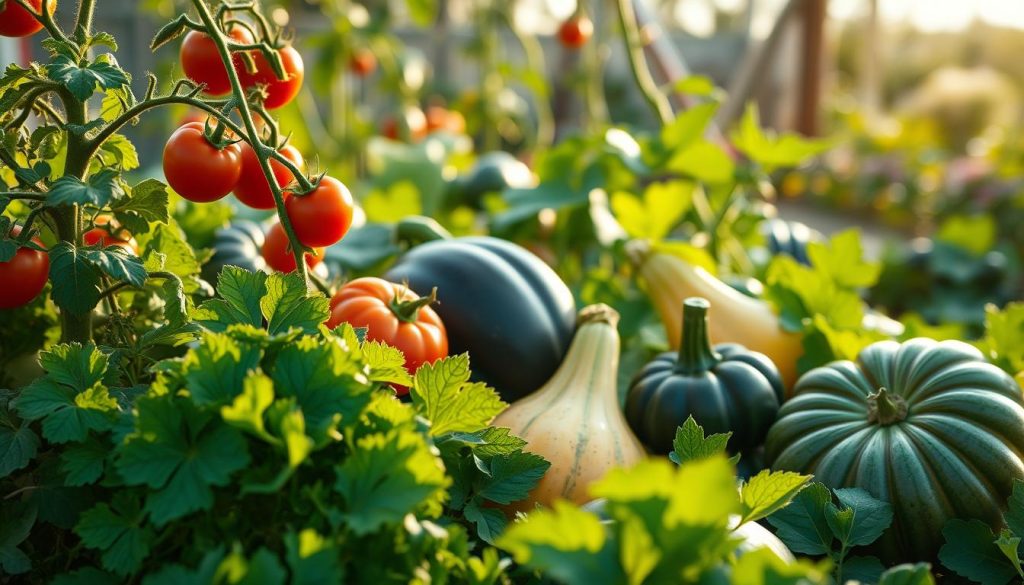
Interpreting Seed Catalog Yield Information
Seed catalogs often boast about veggie yields, but you need to read between the lines. Terms like “high-yield” can be misleading and not always true in your garden.
When checking yield claims, look for specific numbers. Useful metrics for gardeners include:
- Pounds of produce per plant
- Number of fruits per square foot
- Total harvest period length
- Days to maturity combined with production duration
Compare varieties using the same units. For example, a tomato that produces 15 pounds per plant is more informative than one called “very productive.” Be cautious of photos showing perfect veggies that might not be typical.
University trials often give more reliable yield data than marketing. These tests compare varieties fairly under standard conditions. Remember, catalog claims are for ideal conditions, not guaranteed results in every garden.
Top High-yield Tomato Varieties for Home Gardeners
Home gardeners looking for a big harvest should pick high-yield tomato varieties. These tomatoes are some of the best for home gardens, giving lots of fruit all season. With the right choice, one plant can give you pounds of tomatoes.
Choosing the right tomato varieties is key to a big harvest. These top producers turn small gardens into food factories. They keep your kitchen full of fresh tomatoes for months.
Indeterminate Varieties for Continuous Harvests
Indeterminate tomatoes are like marathon runners in your garden. They keep producing fruit until frost kills them. Unlike determinate tomatoes, they grow taller and keep setting new fruit all season.
‘Big Beef’ is a standout for its flavor and disease resistance. A well-supported ‘Big Beef’ plant can give you 20-30 pounds of tomatoes. ‘Better Boy’ holds a Guinness World Record for most tomatoes from one plant, with 342 pounds.
‘Sungold’ is sweet and comes in an indeterminate cherry tomato package. With the right care, these varieties can give you 3-4 times more fruit than determinate ones. They need strong support and regular feeding to thrive.
Disease-resistant Cultivars for Reliable Production
Disease can ruin a garden. Choosing tomatoes with built-in disease resistance helps your plants keep producing. Modern breeding has made high-output crops that fight off common tomato diseases.
‘Early Girl’ fights off verticillium and fusarium wilts, two big tomato diseases. It gives medium-sized fruits in 50-60 days. ‘Mountain Magic’ is great against late blight, a disease that can wipe out tomato crops.
‘Defiant PhR’ fights both early and late blight and gives tasty, medium-sized red fruits. ‘Iron Lady’ has triple resistance to early blight, late blight, and septoria leaf spot. These varieties ensure you get a steady harvest even in tough seasons.
Cherry Tomatoes for Abundant Yields
Cherry tomatoes are the winners for the most fruit. They are small but pack a punch, often giving hundreds of fruits per plant. Their size lets them focus on producing lots of fruit.
‘Sweet 100’ is known for its sweet, bite-sized fruits, often giving over 100 tomatoes per plant. ‘Juliet’ has slightly larger fruits that resist cracking and can give up to 350 tomatoes per plant.
‘Sun Gold’ is sweet and keeps producing well into fall. ‘Black Cherry’ brings the flavor of black heirloom tomatoes to a super-productive cherry variety. These plants need harvest baskets with handles because you’ll pick several pounds of fruit each time.
| Variety | Type | Days to Maturity | Yield Potential | Key Disease Resistance |
|---|---|---|---|---|
| Better Boy | Indeterminate | 70-75 | 15-45 lbs per plant | V, F, N |
| Sun Gold | Indeterminate Cherry | 57-65 | Hundreds of fruits | F, TMV |
| Mountain Magic | Indeterminate | 65-70 | 10-15 lbs per plant | V, F, EB, LB |
| Juliet | Indeterminate Grape | 60 | Up to 350 fruits | EB, LB, BER resistant |
| Big Beef | Indeterminate | 73 | 20-30 lbs per plant | V, F, N, TMV, St |
Prolific Pepper Varieties Worth Growing
Peppers are great for gardeners wanting lots of variety and flavor. They grow well in warm weather and keep producing until frost. A small pepper patch can give you enough for fresh eating, preserving, and sharing.
Peppers are also very nutritious. They have vitamins A and C and antioxidants. There’s a pepper for every garden and taste preference.
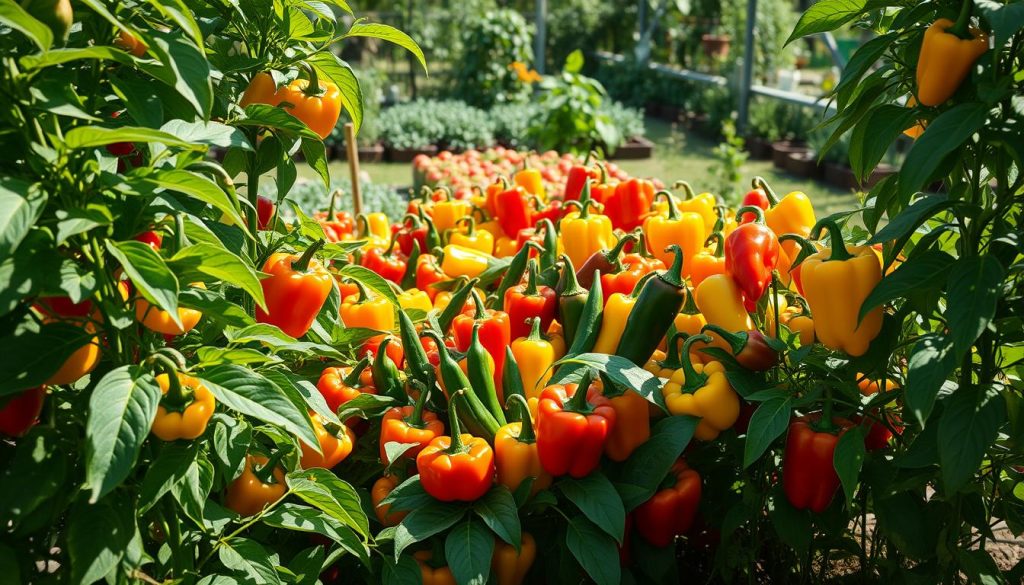
Sweet Bell Peppers That Keep Producing
Sweet bell peppers are essential in the kitchen. They turn from green to red, yellow, or orange as they ripen. They taste best when fully mature.
‘California Wonder’ is a favorite for home gardeners. It produces large, square fruits that turn red. Each plant can give 8-10 peppers.
‘King Arthur’ is known for early production and resistance to blossom end rot. ‘Gourmet’ offers a variety of colors on robust plants.
- Remove the first few flower buds to encourage stronger plant growth
- Apply a calcium-rich fertilizer to prevent blossom end rot
- Harvest peppers regularly to stimulate continued production
- Provide consistent moisture, specially during fruit development
Hot Pepper Varieties with Impressive Yields
Hot pepper lovers get some of the most productive plants. These plants can produce dozens of fruits, making them great for small spaces.
‘Jalapeño Early’ gives a fast-growing jalapeño experience. It produces 30-40 peppers per plant, perfect for salsa.
‘Thai Hot’ peppers grow in clusters, yielding 50-100 small, spicy fruits. ‘Serrano’ peppers are reliable and versatile, producing 40-50 peppers per plant.
- Grow hot peppers in the hottest part of your garden
- Slightly stressing plants with reduced water (once established) can increase capsaicin content
- Harvest frequently to encourage continued flowering
- Consider growing in containers to extend the season by moving plants to protected areas during cool weather
Compact Pepper Plants for Small Spaces
Even with limited space, you can still grow peppers. Modern varieties are smaller but still produce full-sized fruits. They’re perfect for containers and small gardens.
‘Redskin’ bell pepper is only 18-24 inches tall but yields standard-sized red fruits. It’s great for patio containers.
‘Mohawk’ produces yellow-orange fruits on plants under two feet tall. ‘Basket of Fire’ offers decorative plants with small, colorful hot peppers.
- Choose containers at least 12 inches deep and wide for pepper plants
- Use high-quality potting mix with added compost for container-grown peppers
- Place pots in locations receiving at least 6 hours of direct sunlight
- Consider self-watering containers to maintain consistent moisture levels
When picking pepper varieties, mix different types for a longer harvest. With the right care, your garden will give you months of colorful, tasty peppers.
High-yield Vegetable Varieties in the Cucurbit Family
The cucurbit family, including cucumbers, zucchini, and winter squash, is a top choice for gardeners. These vegetables are stars of summer harvests, often producing more than enough for fresh eating and sharing. They are perfect for gardeners looking for big returns from small spaces.
Many cucurbits offer long harvest periods, even until the first frost. Their growth and ability to thrive in warm weather make them rewarding for home gardeners. With the right varieties, you can enjoy a bounty of these versatile vegetables all season long.
Space-efficient Cucumber Varieties
Compact cucumber varieties deliver impressive harvests without taking up a lot of space. ‘Marketmore 76’ is a reliable choice, offering disease resistance and consistent yields of 8-10 inch dark green slicing cucumbers. A single plant can produce 10-15 pounds of cucumbers over its growing season.
‘Straight Eight’ is popular for its uniform, straight fruits and dependable production. For small gardens, bush varieties like ‘Spacemaster’ and ‘Bush Champion’ offer impressive yields without needing trellising. These compact plants grow only 2-3 feet wide yet can produce up to 12 pounds of cucumbers per plant.
Pickling cucumber varieties like ‘National Pickling’ and ‘Boston Pickling’ produce smaller fruits but in greater quantities. They are excellent for preserving enthusiasts. With regular harvesting, these varieties continue producing throughout the season.
Productive Zucchini and Summer Squash
Zucchini is a symbol of garden abundance. The classic ‘Black Beauty’ zucchini can produce 3-4 pounds of squash per week from a single plant during peak season. Many gardeners find that just 1-2 plants provide more than enough for a family of four.
‘Cocozelle’ offers impressive yields with distinctive striped fruits that are slightly less prone to becoming oversized than other varieties. For something different, ‘Costata Romanesco’ produces heavily ribbed fruits with exceptional flavor that many consider superior to standard zucchini.
Yellow summer squash varieties like ‘Early Prolific Straightneck’ and ‘Multipik’ live up to their names with abundant harvests. The key to maximizing production with all summer squash is frequent harvesting—picking fruits when they’re 6-8 inches long encourages plants to continue producing new flowers and fruits rather than focusing energy on developing larger existing fruits.
Winter Squash Varieties with Maximum Storage Potential
While winter squash plants typically produce fewer individual fruits than their summer cousins, their storage capability makes them valuable high-yield crops. ‘Waltham Butternut’ remains the gold standard for productivity and storability, with each plant yielding 4-5 squash weighing 3-5 pounds each. These can be stored for 3-6 months under proper conditions.
‘Honey Bear’ acorn squash offers impressive yields on compact plants, making it suitable for smaller gardens. Each plant produces 3-5 fruits that store for 2-3 months. For gardeners with very limited space, ‘Sweet Dumpling’ delivers 8-10 small (1-pound) squash per plant with delicious flavor and 3-4 month storage potential.
‘Buttercup’ and ‘Burgess Buttercup’ varieties combine excellent flavor with good productivity, yielding 3-4 squash per plant that can store for up to 6 months. This extended storage capability effectively multiplies the usable yield of these productive crops, providing homegrown vegetables long after the growing season ends.
| Cucurbit Variety | Average Yield Per Plant | Space Required | Days to Maturity | Storage Potential |
|---|---|---|---|---|
| Marketmore 76 Cucumber | 10-15 pounds | 2-3 sq ft (trellised) | 58-65 days | 1-2 weeks refrigerated |
| Spacemaster Cucumber | 8-12 pounds | 4-6 sq ft (bush type) | 55-60 days | 1-2 weeks refrigerated |
| Black Beauty Zucchini | 20-30 pounds | 9-16 sq ft | 45-55 days | 1-2 weeks refrigerated |
| Waltham Butternut Squash | 15-25 pounds | 12-20 sq ft | 85-100 days | 3-6 months |
| Sweet Dumpling Squash | 8-10 pounds | 9-12 sq ft | 80-90 days | 3-4 months |
Leafy Greens That Keep on Giving
Leafy greens are top for long harvests in home gardens. They turn small spaces into food factories. With the right types and harvesting, a small planting can last weeks or months.
Choosing high-yielding cultivars is key. These varieties regrow after cutting, offering a steady supply. They outperform traditional types in harvests.
Cut-and-Come-Again Lettuce Varieties
Cut-and-come-again lettuce is super efficient. You can snip outer leaves and the center keeps growing. This gives you many harvests from one planting.
‘Salad Bowl’ lettuce is a top producer. Its leaves regrow fast after harvesting. Oak-leaf varieties, red and green, are heat-tolerant and produce for up to two months.
‘Lollo Rossa’ adds ruffled red-tinged leaves to your salads. It keeps producing new growth after multiple cuttings.
To get the most, cut leaves an inch above the soil. This encourages new growth and extends harvests.
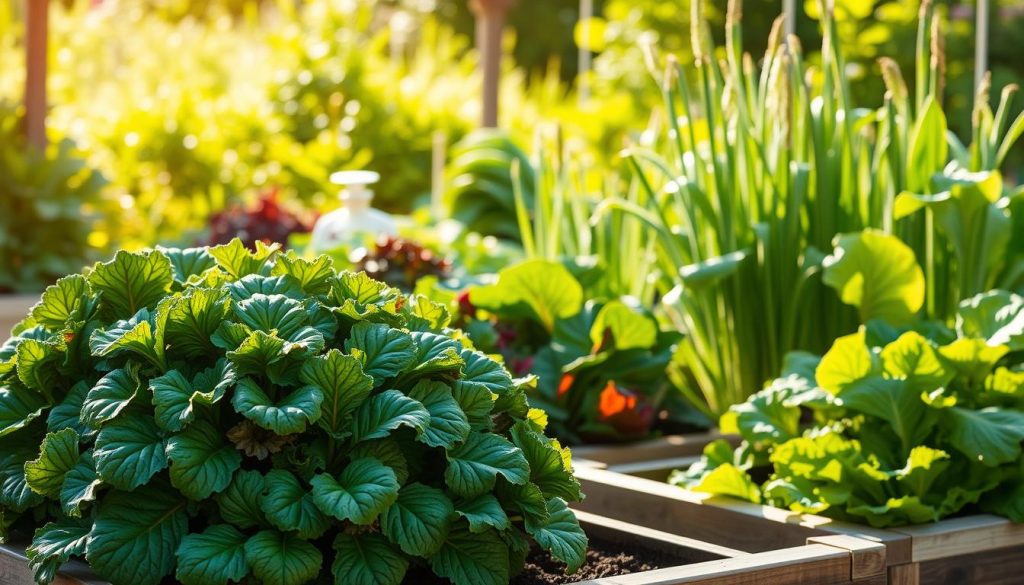
Kale and Collard Varieties for Extended Harvests
Kale and collard greens are long-term producers. They can last months and even survive winter in many zones. They are true garden workhorses.
‘Lacinato’ kale is cold-tolerant and produces from early summer to winter. Its leaves stay flavorful even after frost.
‘Redbor’ kale has stunning purple-red leaves and is very productive. ‘Champion’ collard greens produce large, tender leaves for months. These varieties get sweeter after light frosts.
Swiss Chard and Spinach for Continuous Production
Swiss chard and spinach are perfect for continuous harvests. They are beautiful, nutritious, and keep producing. They are key for gardeners wanting lots of food.
‘Bright Lights’ Swiss chard has colorful stems and produces for months. Chard is resilient – just harvest outer leaves for new ones to grow. A single planting can last a whole season.
‘Bloomsdale’ spinach is a top choice for spinach. Its leaves regrow quickly after cutting. For continuous spinach, plant new seeds every 2-3 weeks. This keeps your spinach supply fresh.
Root Vegetables with Impressive Yields
Root vegetables are great for getting the most out of your garden. They use space underground to grow, often producing a lot of food per square foot. This is because they grow where other plants can’t.
These veggies also keep well, letting you enjoy them long after they’re picked. Choosing the right varieties and growing them right can really boost your harvest.
Carrots That Maximize Underground Space
Choosing the right carrot variety can really help your harvest. Home garden varieties often grow bigger and more uniform than others.
‘Danvers’ carrots do well in heavy soils, growing thick and long. ‘Nantes’ carrots are sweet and grow straight, using space well. ‘Bolero’ carrots are disease-resistant and grow to 7-8 inches, consistently.
- Prepare soil 12-18 inches deep, removing rocks and breaking up compacted layers
- Space rows 12-18 inches apart to maximize root development
- Thin seedlings to 2-3 inches apart for optimal sizing
Radishes and Turnips for Quick, Abundant Harvests
Radishes and turnips grow fast, ready to eat in just a few weeks. This lets you plant them multiple times in one season.
‘Cherry Belle’ radishes are ready in 21 days, perfect for planting every two weeks. ‘Easter Egg’ radishes are colorful and grow in 30 days, even in poor soil. ‘White Icicle’ radishes stay good in hot weather.
‘Tokyo Cross’ turnips are ready in 35 days and stay tender in summer. ‘Purple Top White Globe’ turnips have edible greens and sweet roots, doubling your harvest.
Potatoes with High Tuber Production
Potatoes are super productive for gardeners, with one plant yielding 5-10 pounds. Choosing the right varieties can really increase your harvest.
‘Yukon Gold’ potatoes are adaptable and yield 7-8 pounds per plant. ‘Kennebec’ potatoes grow many large tubers. ‘Red Pontiac’ potatoes yield a lot and keep well for winter.
- Use the “hilling” technique, adding soil around stems as plants grow to encourage more tubers
- Grow bags and containers with proper drainage can increase yields by 30% over traditional methods
- Harvest after flowers fade for baby potatoes or wait until tops die back for maximum yield
Legumes That Produce Abundantly
Legumes are a top choice for gardeners, offering high yields and improving soil health. They work with soil bacteria to capture and convert nitrogen into a form plants can use. This natural process benefits your garden as a whole.
Legumes vary in size and growth, from small bushes to climbing vines. With the right planning, they can provide a steady supply of food all season. They are key to a productive home garden.
Bush Bean Varieties for Concentrated Harvests
‘Provider’ bush beans are known for their early, bountiful harvests. They mature in 50 days and fight off many diseases, making them great for new gardeners.
‘Blue Lake Bush’ beans are loved for their taste and productivity. Their pods are tender and stringless, even when picked a bit late.
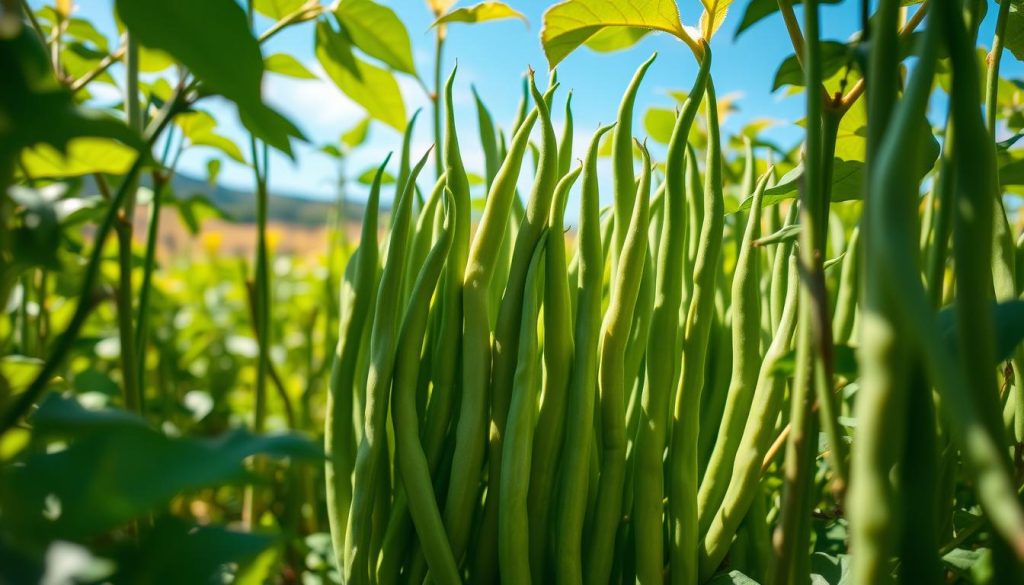
‘Royal Burgundy’ beans have striking purple pods that turn green when cooked. To get the most from them, plant new seeds every 2-3 weeks.
Pole Beans for Extended Production
‘Kentucky Wonder’ pole beans are a classic choice for gardens. Once they start climbing, they can keep producing for months, often more than bush beans.
‘Rattlesnake’ beans have beautiful purple-streaked pods and can handle heat well. Their long, tender pods extend your harvest season.
‘Scarlet Runner’ beans are a double treat with their red flowers and tasty beans. For the best results, use tall trellising to support these climbers.
Peas That Maximize Vertical Space
‘Super Sugar Snap’ peas have sweet pods and grow up to 6 feet tall. They produce for a long time, if you harvest them regularly.
‘Oregon Giant’ snow peas have large, flat pods great for stir-fries. Their vines are about 3 feet tall, perfect for smaller spaces.
‘Green Arrow’ shelling peas have up to 11 peas per pod. Plant them in spring and fall for a continuous harvest. Use trellising early to avoid damaging roots.
Productive Herb Varieties for Home Gardens
Herbs are a standout in home gardens for their high yield and versatility. They need little space and give continuous harvests. Adding herbs to your garden boosts your cooking and provides fresh produce all year.
Whether you have a lot of land or just a few pots, the right herbs can make a big difference. Many herbs grow better when picked often, giving gardeners more from their space.
Perennial Herbs That Keep Giving
Perennial herbs are a great choice because they keep giving year after year. Oregano, like ‘Greek’ and ‘Hot and Spicy’, spreads out and gives leaves all season. Cutting them back keeps them bushy and prevents them from becoming woody.
Thyme and rosemary are also top choices for perennial herbs. Thyme, like ‘English’ and ‘Lemon’, grows low and can be picked many times. Rosemary, like ‘Tuscan Blue’ and ‘Prostrate’, gives fresh leaves all year in warm places.
Mint is very productive but needs to be kept in check. One mint plant can make dozens of teas, cocktails, and dishes all season.
Annual Herbs with Impressive Leaf Production
Annual herbs need to be replanted every year but produce a lot during their season. ‘Genovese’ basil is a leaf-making champion, giving many harvests if cared for right. To get the most, cut off the top of the stem, not individual leaves.
- ‘Bouquet’ dill has lots of leaves great for fish and pickling
- Cilantro can be planted every 2-3 weeks for endless harvests
- ‘Italian Large Leaf’ parsley gives a lot of nutrient-rich leaves
- ‘Sweet Marjoram’ grows well in small spaces and gives lots of leaves
To keep these herbs productive, remove flower buds as soon as they show up. This helps the plant focus on making leaves, not seeds.
Container-friendly Herb Varieties
You don’t need a lot of space to grow herbs. Many small varieties do well in pots and give a lot of yield. ‘Spicy Globe’ basil fits perfectly in a 10-inch pot and tastes great.
Dwarf sage, like ‘Minimus’, has the same flavor as bigger varieties but is smaller. These herbs give a lot of fresh produce without needing a lot of room.
To make the most of small spaces, mix herbs in a way that uses vertical space well. Trailing herbs like rosemary or thyme can spill over, while upright ones like basil or parsley take the middle. This way, you get more herbs and your garden looks good too.
Maximizing Yields Through Proper Growing Techniques
To get the most out of high-yielding seeds, you need to know the basics of growing. Even the best seeds won’t do well without the right care. Focus on spacing, fertilizing, and watering to make your garden more productive.
Optimal Spacing for Productive Gardens
Spacing is key for a good harvest. Too close, and plants fight for resources. Too far, and you waste space.
Try square foot gardening for more in less space. It keeps plants healthy and prevents disease.
| Vegetable | Traditional Spacing | Intensive Spacing | Yield Impact |
|---|---|---|---|
| Tomatoes (Indeterminate) | 36″ apart | 24″ with trellising | 30-40% increase |
| Bush Beans | 6″ apart, rows 24″ apart | 4″ apart, rows 12″ apart | 25% increase |
| Leafy Greens | 6-12″ apart | 4-6″ apart | 50% increase |
| Peppers | 18-24″ apart | 12-18″ apart | 15-20% increase |
Fertilization Strategies for High-yielding Plants
Each plant has its own needs. Use the right fertilizer at the right time.
Tomatoes and peppers need phosphorus when they’re producing fruit. Leafy greens like nitrogen. Root veggies need potassium.
When to fertilize matters. Use compost or slow-release fertilizers at planting. Liquid fertilizers during growth peaks. Soil tests can spot missing nutrients.
Watering Practices That Boost Production
Keep plants moist for best growth. Water stress can hurt yields, even later.
Drip irrigation saves water and prevents disease. It can increase yields by 30%.
Mulch keeps soil moist and weeds away. Use 2-3 inches of organic material. It helps during dry spells.
Turning Your Garden into a Vegetable Powerhouse
With the right knowledge, you can turn your garden into a food powerhouse. Start by making a seasonal planting calendar. This will help you grow fast crops like radishes and lettuce, along with longer-season veggies like tomatoes and winter squash.
Plant in stages for a constant supply of fresh food. In warmer areas, grow cool-season crops in fall and winter. For those in colder zones, use succession planting in summer for ongoing harvests.
When your garden produces more than you can eat, start preserving. Freezing is great for most veggies. Canning is best for tomatoes and pickled items. Dehydrating herbs and fermenting cabbage into sauerkraut keeps your harvest fresh through winter.
Home-grown veggies save money and taste better than store-bought. They’re packed with nutrients that start to lose value right after picking. Eating from your garden is the healthiest choice.
Even small gardens can feed your family all year with careful planning. Your garden is more than a hobby—it’s a sustainable food source right outside your door.

